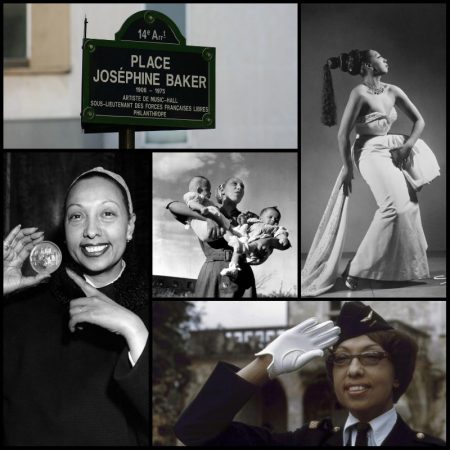
Josephine Baker, an extraordinary woman (Clockwise from top left: la place Joséphine-Baker, Paris’ 14ème arrondissement, ©shelleybell/Pixabay; glamour photo in Havana, 1951, courtesy UCLA Library; receiving the Légion d’Honneur, 1961, ©Georges Menager for Paris Match; receiving the city of Paris medal, 1956, ©AP Photo. Center: with two of her adopted children, 1950, ©Roger-Viollet Collection/Getty Images)
“J’ai deux amours, mon pays et Paris” (“Two loves I have, my country and Paris”) – from Josephine Baker’s signature song “J’ai deux amours”, lyrics by Géo Koger & Henri Varna, music by Vincent Scotto)
On November 30, 2021, Josephine Baker will become the first woman of color, as well as the first entertainer ever, to be inducted into the French Panthéon. But how did a black girl, born and raised in the dire poverty of the early 20th century slums of St. Louis, Missouri, become “La Joséphine”, and why is she being given the highest honor for a French citizen? The young Freda Josephine witnessed some traumatizing events of racial violence while growing up, several of which are accounted in her autobiography, as well as in the numerous books written about her. A school dropout by 12 and practically homeless at 13, she took up any job she could get or danced in the streets to survive. Already in her second marriage by the time she was 15, and wanting to escape the controlling pressures of her mother (her relationship with whom would remain forever problematic), she toured with her vaudeville troupe, eventually making it as a Broadway chorus girl in 1921. Dissatisfied with the limited professional opportunities, and with the ever-burning desire to break free from her husband and mother, the 19-year old Josephine Baker gladly accepted an offer to go to Paris.
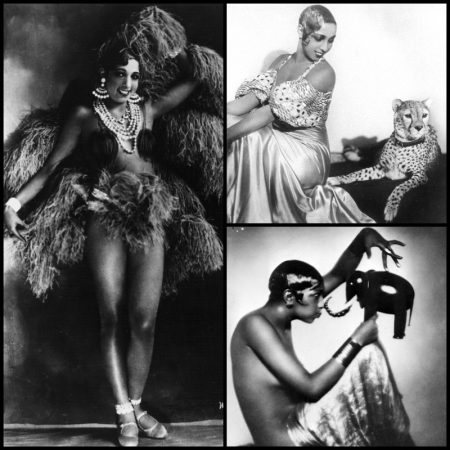
Josephine Baker, 1920s-1930s (Clockwise from top right: with her pet cheetah Chiquita, photo by Piaz; portrait, 1928, photo by Studio Ora; in costume for her Folies Bergères show, 1930s, photo by Walery)
She couldn’t have arrived at a more opportune moment in the “City of Light”: the year was 1925, and many members of the “Lost Generation” had chosen Paris as their refuge. As a result, a fantastic crowd of international expats was living and creating in the city, next to French-born artists, authors and scientists. Infused with the brilliance of foreigners like Ernest Hemingway and F. Scott Fitzgerald, Pablo Picasso and Man Ray, Gertrude Stein and James Joyce, or Igor Stravinsky and Cole Porter, Paris was bursting with energy, altogether creative and progressive. The city was ready to welcome a black entertainer as a star, and Baker was indeed embraced as such: she became an overnight sensation, with an idiosyncratic performing style that included wild, erotic dancing, occasional nudity, exuberant singing, and physical comedy elements. Her daring costumes (most notably, her banana belt-skirt) and unexpected “accessories” (she often appeared with a pet cheetah) concluded the image of a performer the likes of whom Paris had never quite seen. She soon became the toast of the town; the hosts wanted her at their parties, the greatest couturiers of the era desired to dress her, the finest things that life had to offer (including expensive perfume) were at her feet. After her European triumph, Baker decided to go back to the USA for a major part in the “Ziegfeld Follies of 1936” Broadway revue. She received unjustifiably hostile reviews, many of them racially charged and downright biased. Shocked and humiliated, she returned to France, got married and became a French citizen.
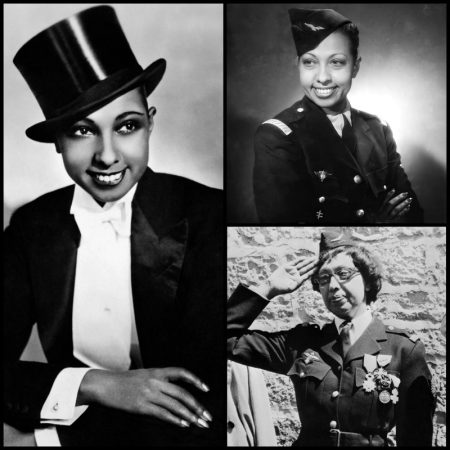
Josephine Baker, woman of strength (Clockwise from top right: in uniform, 1944, photograph by Studio Harcourt; receiving the Légion d’Honneur & Croix de Guerre in France, 1961, ©AFP; in top hat, ca. 1933, photograph by Teddy Piaz)
When France declared war on Hitler’s Germany in 1939, Josephine Baker was recruited by the French military intelligence agency due to her ease of moving inside private parties, the homes of the powerful, and even foreign Embassies. When the Nazis invaded Paris in 1940, she knew that a black woman wouldn’t be safe there anymore; she took shelter in her Château in the South of France. Her contributions to the war effort were numerous: starting by hiding Resistance members in her estate, she eventually became a secret agent. She would take advantage of her ability to travel as a performer to places like Portugal, Great Britain, South America or Northern Africa, and transmit every bit of information she could gather, carry hidden military messages and even entertain troops in between. The risks she took and the dedication she showed were awarded with the Croix de Guerre and the Rosette de la Résistance, and she was also named Chevalier of the Légion d’Honneur.

Josephine Baker, 1950s-1960s (Clockwise from top right: performing in New York, 1951, ©Alfred Eisenstaedt for LIFE magazine; with then husband Jo Bouillon and her “Rainbow Tribe”, 1950s, ©Collection Roger-Viollet; during the March in Washington, 1963, ©Dalmas Agency)
After the end of WWII, Baker reinvented herself as a more mainstream, mature performer, while remaining a tireless champion of human rights and racial equality. When the civil rights movement grew in her home country, Baker wanted to contribute. She accepted to perform again in the USA in 1951, this time to great acclaim. Targeted by the FBI due to calling out segregation practices in nightclubs, she wouldn’t be allowed back in USA for almost a decade. She returned in the 1960s to perform, but to also make anti-racism speeches and join marches; in 1963, she even shared the podium with Martin Luther King Jr. during the March on Washington (she greeted the mixed-race crowd with “salt and pepper – just what it should be”, delivering a passionate speech). To prove her point that all human beings should peacefully live together, she adopted a dozen children of all races (her “Rainbow Tribe”), raising them in her Château des Milandes estate. Unfortunately, due to poor financial management she lost her significant fortune, ending up living in an apartment provided by her good friend, Grace Kelly (by then, Princess of Monaco).
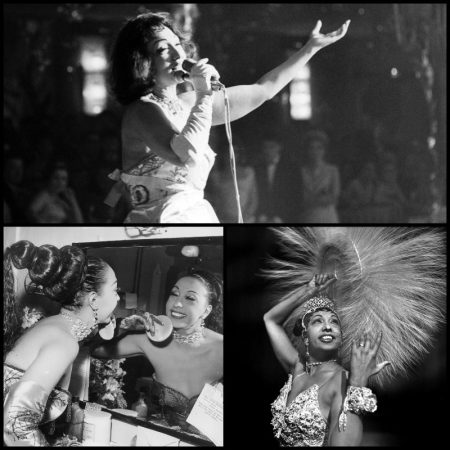
Josephine Baker, post-WWII diva (Clockwise from top: performing at the Madame-Ball, 1963, ©Gerhard Rauchwetter; bottom right: at the Olympia stage in Paris, 1959, ©Studio Lipnitzki/Collection Roger-Viollet; backstage at the N.Y. Strand Theater, 1951, ©Hulton Archive)
Josephine Baker was blessed with a triumphant comeback on the French stage in 1975 that could have led to a new series of worldwide shows. Sadly, she passed away only four days later, at the age of 68. At the time she was largely admired worldwide, although according to some biographers she had become increasingly volatile, sometimes difficult to work with and not exactly trustworthy in her business dealings. Retrospectively, some even question her choice to create such a large family, without making sure she could steadily provide the needed time and financial support. We can perhaps agree that Miss Baker wasn’t without controversies or paradoxes (for these, I point you to “Josephine: The Hungry Heart”, written by her foster son, Jean-Claude Baker, and Chris Chase). Nobody, however, can deny Josephine Baker’s inspiring artistic legacy (she paved the way for African-American star performers like Diana Ross or Beyoncé) or her invaluable example of bravery through her anti-Nazi war efforts and subsequent activism.
In view of her complex personality and extraordinary accomplishments, it gives me pleasure to imagine a perfume collection in her memory. I hope that the artist and fighter Josephine would have been as pleased with the following choices, as the perfumista and coquette in her.
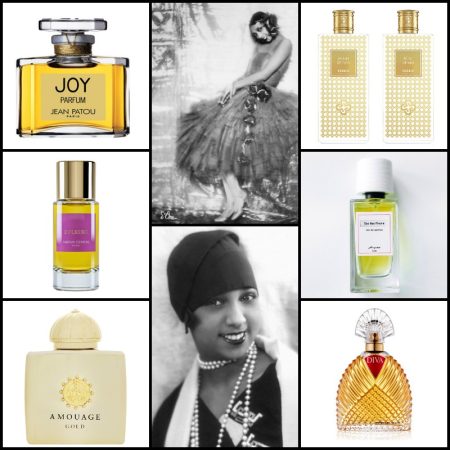
(Top center: wearing Patou, 1927, photo by Madame d’Ora; bottom center: portrait, c. 1925, ©PictureLux/The Hollywood Archive)
Josephine Baker Patou Joy lover: Josephine Baker was a great fan of Jean Patou’s ethereal haute couture gowns and functional sporty ensembles; she’s also said to have favored the House’s iconic perfume Jean Patou Joy (Henri Alméras, 1930). That is hardly surprising, since it takes a woman of a certain grandeur to effortlessly pull off the demanding beauty of vintage Joy’s “nuclear” rose and jasmine combination, topped off with aldehydes, sandalwood and a hefty dose of civet. Elaborating on Josephine’s fascination with this perennial floral duo, I think she would have enjoyed Parfum d’Empire 3 Fleurs (Marc-Antoine Corticchiato, 2009), a modern-day descendant of Joy, where prominently featured rose and jasmine mingle with tuberose in a heady, extravagant floral concoction with galbanum touches and white musk background. Amouage Gold Woman (Guy Robert, 1983) would have satisfied Miss Baker’s taste for luxury with its gilded, aldehydic floral bouquet (mainly rose and jasmine, with muguet and iris accents), embellished by summer fruits and vanillic woods, alluring myrrh and silver frankincense. For an airier, but wonderfully natural in feel, rose and jasmine pairing, I’d suggest layering together Perris Monte Carlo Rose De Mai and Jasmin De Pays (Jean-Claude Ellena, 2019); those masterful – photorealistic yet idealized – soliflores depict the aromas of rose centifolia and jasmine grandiflorum when they’re blooming in Grasse, and their combined magic enhances their individual impact. Senyokô Duo Des Fleurs (Euan McCall, 2019) would make for a bold, yet fascinating, choice with its original handling of the main floral pair: surrounded by davana, datura, sandalwood and a mitti attar accord, rose and jasmine become the protagonistic lyrical duo of an intoxicating olfactive opera. I can finally envision a bottle of Ungaro Diva (Jacques Polge, 1983) on Josephine’s boudoir: this stunning floral chypre revolves around a honeyed, powdered rose and jasmine floral heart, and I think she would have been pleased to see the curvy, pleated glass bottle with the word “DIVA” on bright red, right next to her beloved, comparatively austere, crystal flacon of Joy.
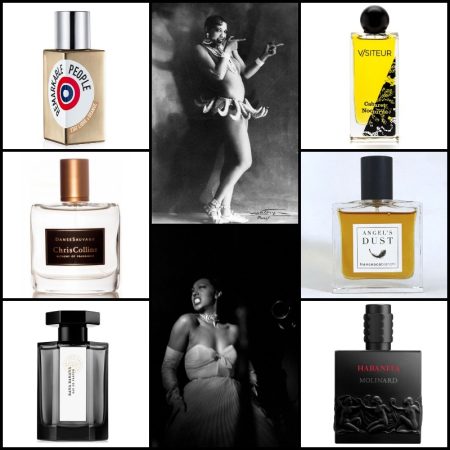
Josephine Baker, sensational performer (Top center: at the Folies Bergères, 1926, ©Walery; bottom center: performing in Harlem, 1950, ©Eve Arnold/Magnum)
Josephine Baker, sensational performer: Initially released as “Josephine Baker” in 2010, État Libre d’Orange Remarkable People (Cécile Matton-Polge, 2015) justly belongs to this imaginary perfume table: its ebullient mixture of citruses, florals and light woods, doused with a bubbly champagne accord, instantly sets the mood for “Paris by night” escapades. Released by an African-American-owned brand, Chris Collins Danse Sauvage (Marie Patricia Hurel, 2017) is named after Baker’s uninhibited, sensual dance routine that made her famous, and – as a tribute to her – it would naturally intrigue her; its gender-fluid combination of boozy, spicy plum and substantial woody notes would make for an interesting fragrance choice for Miss Baker (who, incidentally, liked sporting men’s tuxedos every now and then). L’Artisan Parfumeur Bana Banana (Céline Ellena, 2019) also emerges as a heavenly option: more than just referencing Josephine’s banana skirt, this ambery, softly spiced jasmine scent with generous fruity tones irradiates humorous, playful energy – the kind of energy that was in the core of Baker’s performing persona. Visiteur Cabaret Nocturne (Cécile Zarokian, 2018) evokes an aura of a jazz club after midnight through its spiced, seductive tuberose that is surrounded by fizzy, smoky and animalic vibes: gin and tonic served amidst an aromatic cloud of face powder and lipstick, white flower corsages and cigarettes. Right next to it, I’d place Francesca Bianchi Angel’s Dust (Francesca Bianchi, 2016) for its feeling of backstage boudoir luxury: a powdery bouquet featuring mimosa, iris and rose lies on a spectacular base of balsams, resins, vanilla and woods. I’d finish this particular selection with the evergreen classic Molinard Habanita (Henri Bénard, 1921), whose flapper-era charm still appeals to this day thanks to a powdery halo of playful decadence, warm flowers, dusky smokiness, vanillic vetiver and impressions of leather and tobacco.
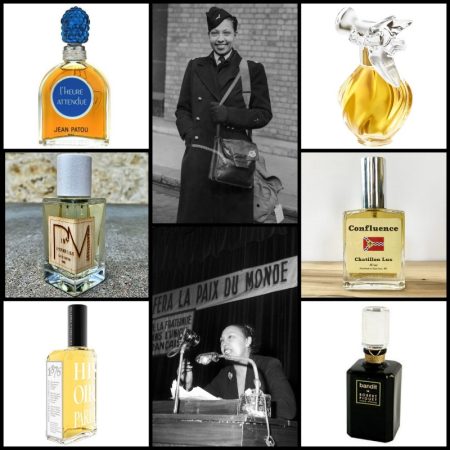
Josephine Baker, WWII secret agent and activist (Top center: in uniform outside the London Savoy Hotel, 1945, ©Keystone Press Agency Ltd.; bottom center: at an anti-racist conference in Paris, 1953, ©Keystone Press Agency Ltd.)
Josephine Baker, WWII secret agent and activist: Baker’s contributions to the WWII effort were such a fundamental chapter in her life that I imagine she would have liked to see it reflected on her own boudoir. I would place there a bottle of Jean Patou L’Heure Attendue (Henri Giboulet, 1946, possibly reworking a formula by Henri Alméras), whose very name (“The Expected Hour”) echoed the immense joy for France’s Liberation; the fragrance was richly woody/spicy, with effervescent citruses and aldehydes, a classic floral bouquet, smoky opoponax and exquisite Mysore sandalwood. Right next to it, should be the iconic Lalique flacon of Nina Ricci L’Air Du Temps (Francis Fabron, 1948); this carnation-dominant, timeless and light-hearted floral heralded a long-awaited change in the ”spirit of times”, and the hope for a passage to a world in peace. I’d like to think that Histoires De Parfums 1876 (Sylvie Jourdet, 2001) would have appealed both to Josephine’s humor (the fragrance is a tribute to notorious WWI spy, Mata Hari), and her taste for sensuous and spicy rose-centric fragrances. With Josephine’s dedication to the cause of racial equality in mind, I believe she would have loved to have at least one fragrance created by a black perfumer. I’d place in her collection a bottle of Pink MahogHany A Mother’s Love (Chavalia Dunlap-Mwampa, 2013), a delicate olfactive hug of peach, mint, rose, pepper and soft musks, composed by an African-American perfumer and brand owner; this fragrance would, furthermore, be a nod to Baker’s dream of harmoniously raising a large, all-encompassing family. Next to it, I’d add a bottle of Chatillon Lux Confluence (Shawn Maher, 2020), composed by a perfumer/brand owner who was raised in Missouri, like Baker; this meditative, grounding blend of precious resins, mystical frankincense and woods from coniferous trees was named to reflect not only the junction of the Mississippi and Missouri rivers, but also the co-existence and merging of various nationalities and cultures during decades of trading side-by-side. My final addition would be a bottle of the avant-garde, unapologetically bitter-green leather chypre Robert Piguet Bandit (Germaine Cellier, 1944); this fragrance that channeled female emancipation like few others in perfume history rightfully belongs to the collection of a woman who struggled, fought, dared and accomplished.
– Despina Veneti, Senior Editor
Follow us on Instagram: @cafleurebonofficial @despinavnt
